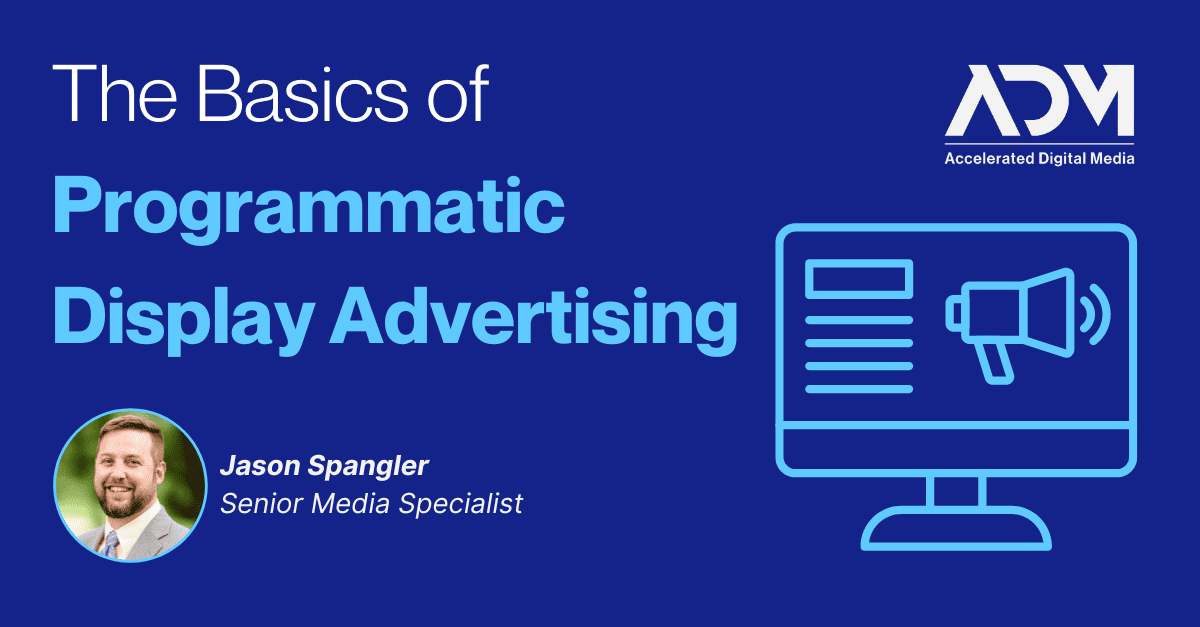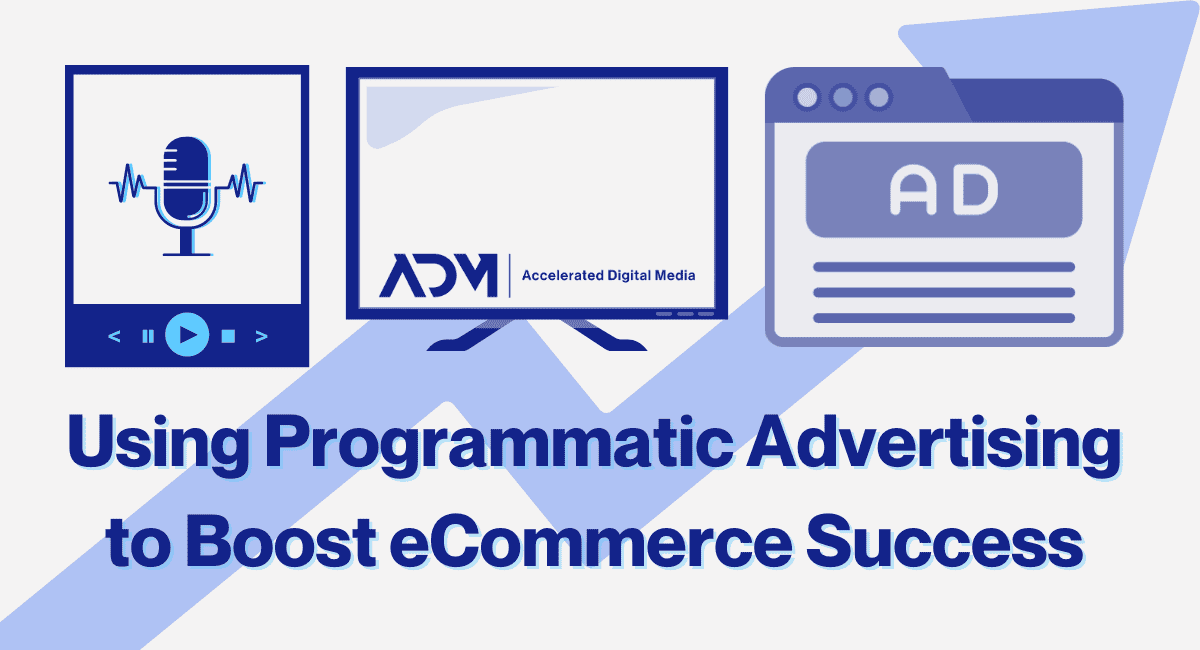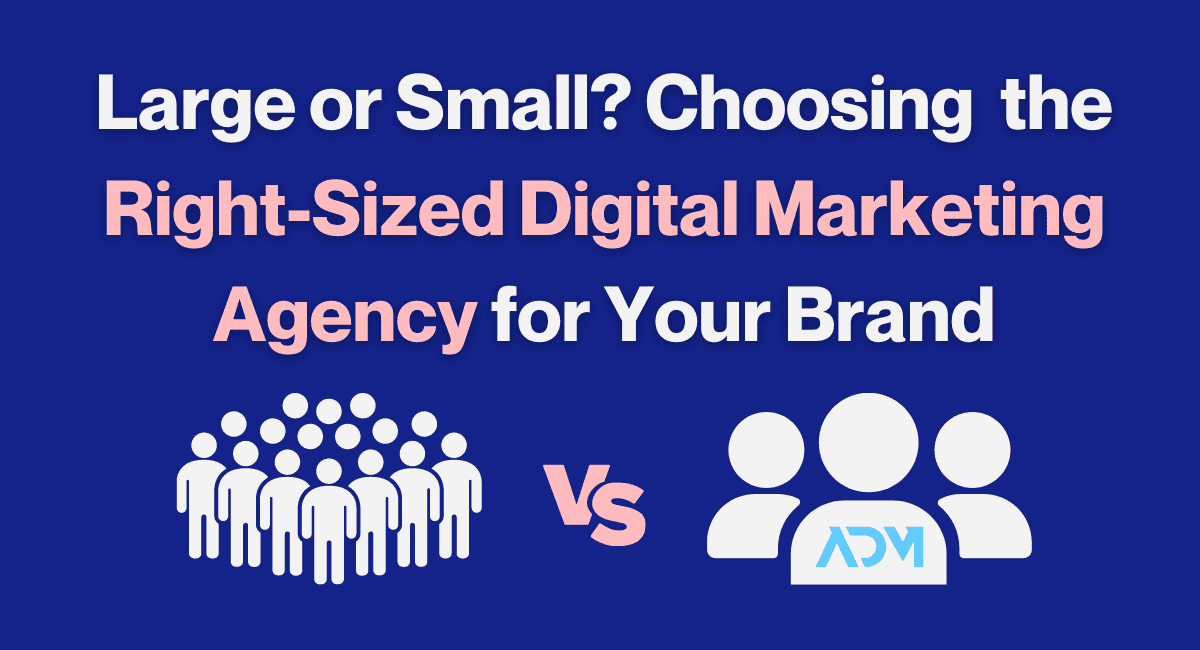Performance marketing relies on using the best combination of digital tools to achieve your business goals, and programmatic ads should be an important part of that mix. Programmatic advertising refers to a number of ways to purchase digital ad property outside of paid social media and SEM. It ranges from sponsored content to podcast and connected TV ads, making it a “big tent” concept that is worth breaking down by medium.
In this blog, we’re going to look at the specifics of programmatic display advertising: what advantages it offers, how it can be placed and targeted, and tips for getting the most out of it.
What is programmatic display advertising?
Simply, programmatic display ads are visual advertisements placed in advertising space that isn’t on a social media network or controlled by the Google Display Network (which is accessed through Google Ads). Unlike Google’s display ad campaigns that reach users across all the web properties associated with that network, programmatic ad buys are often more directed and require more than one platform to deploy campaigns.
What are the main advantages of programmatic display ads?
The core benefits of programmatic display are its flexibility and effectiveness. Those are demonstrated in a number of ways:
Audiences – Either through contextual targeting or behavioral targeting, there are countless customizable ways for advertisers to ensure their message is being placed in front of the right person, in the right place, at the right time.
Scalability – By spanning across multiple ad networks, there is a tremendous opportunity to increase the reach of a brand message.
Efficiency – Lower CPMs (cost per thousand impressions) compared to paid search and paid social allow advertisers to reach more potential customers for the same dollar amount.
Transparency – Being able to monitor campaign performance from the minute ads begin serving lets advertisers make optimizations in real time. This includes the ability for marketers to see performance on the exact sites on which ads are placed and the demographics of the audience viewing them to continually fine-tune campaign structure for desired results.
How do you buy programmatic display space?
Programmatic campaigns rely on the use of demand-side-platforms (also known as DSPs), which allow advertisers to purchase ad placements targeting specific audiences across a wide range of ad exchanges and ad networks. In addition to DSPs, there are a number of other platforms and technologies involved in the ad buying process, including:
- Supply-Side Platforms (SSPs): SSPs are what web publishers use to make their properties available for ad placements and bidding.
- Ad Exchanges: Ad exchanges manage the auction and bid process to determine the winning advertisement for a slot in a publisher’s property.
- Ad Servers: Place the ad in the publisher’s available ad space after a winning bid.
- Data Providers: Provide advertisers with access to information including demographic audience data, topical relevance data, geographical data, and more for targeting purposes.
What types of targeting can you use for programmatic display?
There are two primary ways to target programmatic display placements. Contextual Targeting will place ads directly on web pages based on the page’s content. For example, a men’s clothing company may run ads for dress shirts on a blog article centered around job interview tips. This tactic places ads next to relevant content, ensuring a relevance alignment between what a user is reading and what the advertiser is promoting. This is also highly-effective for health brands, who are limited in the concepts they can target on services like Google Ads and Meta Ads.
On the flip side, Behavioral Targeting (also known as Audience Targeting) will place ads to a specific user based on their browsing behavior. Examples of such behaviors include site visits, previous searches, and add to carts (among others). In the same example as above, the men’s clothing advertiser may have a list of users who have added a dress shirt to their shopping cart. These users can then be served dress shirt ads across the internet, regardless of on-site content.
What are the elements of a good programmatic display ad?
A good programmatic display ad can capture a user’s attention and encourage them to take action. The below elements should be considered when building high-performing display creative:
Clear and Relevant Messaging: Ensure the headline is attention-grabbing and relevant to the intended audience or content being targeted.
Strong Visuals: The ad needs to stand out in a way that pulls the users attention away from the on-site content. This can be done with high quality, eye-catching visuals.
Branding: Utilizing messaging and visuals that are consistent with overall branding efforts will help maximize the impact when targeting users already familiar with the brand. It helps provide a seamless branding experience from past engagement to display ad to landing page. This can include colors, logos, fonts, imagery, and brand voice.
Clear Call To Action: Utilize a clear Call-To-Action (CTA) to encourage the action you want the user to take. It’s best to keep Calls To Action short and without any technical language. Common CTAs include “Shop Now”, “Get Started”, “Learn More”, “Book Now”, and “Try Today”. The CTA should be clearly defined and stand out from the rest of the ad, making it easy for the user to identify where to click and what action to take.
Tips for Programmatic Display Campaigns
Segment campaigns based on goals and audience intent. Utilize contextual targeting for prospecting to ensure your message is aligned with a user’s interest. Further, utilize behavioral targeting to build retargeting campaigns for visitors that clicked through a prospecting effort without converting.
Tailor Creative To Your Audience. If needed, build multiple contextual targeting campaigns based on interest groups to ensure your creative and messaging is closely aligned with a user’s interests. For example, if an advertiser is selling Pet Food, it may make sense to have one campaign for “dog owners” and one for “cat owners”, highlighting relevant products, imagery, and headlines within the creative designed to capture attention of each of them independently.
Be patient! While programmatic ad buying happens quickly and optimizations can be made in real time, it can take some time to fully see the full-funnel impact of programmatic display. We recommend campaign flights of at least 30 days.
How do you measure success in a programmatic display campaign?
Programmatic display ads can be deployed in different ways depending on your brand’s distinct business goals. How you measure that success depends on the metrics you look at.
Top Of Funnel (Awareness): Measure the reach of the campaign by looking at unique impressions while also keeping an eye out for a general lift across all other branded marketing efforts.
Middle Of Funnel (Consideration): Measure traffic coming directly from programmatic display ads by monitoring click activity. These site visitors are not only showing interest in your message with the possibility of converting immediately, but can also help build audiences for retargeting campaigns.
Bottom Of Funnel (Conversion): Utilize pixel data to optimize towards users taking a desired action such as placing an order, making an appointment, or signing up for an email newsletter.
How does the cost of programmatic display compare to other programmatic ads?
Programmatic Display is generally cheaper than other types of programmatic ads, such as podcasts or connected TV. With programmatic display, you can expect CPMs to range between $6-$10, while programmatic podcast buys range from $20-$30 and connected TV buys range from $40-$60.
Due to the efficiencies gained from automating the process and utilizing multiple ad exchanges, Programmatic display is also generally lower cost than buying media directly.
Getting started with programmatic display
If you’re interested in finding out whether programmatic display advertising could help your brand improve its digital marketing performance, reach out to the team at ADM today. We’ll discuss your advertising options and make recommendations based on your specific business goals.




